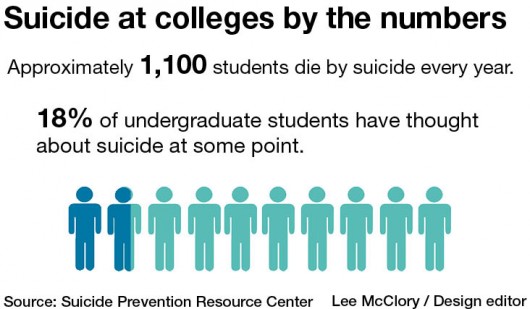“See something. Say something.”
These words are the newest addition to the revised version of an Ohio State guide intended to provide the appropriate resources and coaching to OSU faculty, staff and students when handling a person who might exhibit signs of emotional distress or cause a disruption, a Student Life official said.
Each year, the “Guide to Assist Disruptive or Distressed Individuals” is slightly modified and distributed across campus from Executive Vice President and Provost Joseph Steinmetz’s office, said Micky Sharma, director of the Office of Student Life’s Counseling and Consultation Service. Several thousand hard copies will be distributed this year, he said.
Sharma said the funding for the guide is being managed by the provost’s office.
“When any one of us sees something that is concerning, we take action,” Sharma said. “We want people to say something, do something, to take action. That’s a tagline that I think works.”
The guide includes possible signs of distress, do’s and don’ts for confronting a student who shows signs of disruptive behavior and a list of contact information, including phone numbers, for various resources on OSU’s campus.
According to the guide, suicide is the second-leading cause of death in young adults ages 19-24.
“I don’t think everything you need to know about preventing suicide is in this manual, but I think it’s the best they can do,” said Lizzie Rodeck, a second-year in clarinet performance. “I like the list of phone numbers.”
Although only minor changes were made this year, such as changing the color of the guide from orange to scarlet and gray, Sharma said the revision and distribution of the guide to the OSU community is vital.
“We are at a time right now where there are more students at Ohio State that have had more mental health issues before they come to campus,” Sharma said. “As a community, as an institution, we need to be prepared to support all of our campus.”
Fatima Shaik, a second-year in psychology who used to work at a suicide hotline, said she reaches out to her friends to make sure that their emotional statuses are a part of regular conversation.
“I’ve talked about it with my friends. If you have a friend who’s at risk (of committing suicide), all you need to do is say, ‘I’ve noticed you’re acting this way,’” Shaik said.
Morrison Tower resident adviser Matheus Scuta, a second-year in industrial and systems engineering, said although suicide is perhaps the most severe example of distress, he learned quickly from experience that distress could be exhibited in different ways — he recently dealt with a case with a resident that took six hours to resolve.
Scuta said it was his personal experience adjusting to a new life at OSU after being raised in Brazil that helps him confront distressed behavior in his residents.
Resident advisers must participate in a two-week training that covers the basic principles of the guide, Scuta said. REACH is a 60-minute to 90-minute suicide prevention training program also available to the OSU community, Sharma said.
Scuta said it’s important to talk with emotionally distressed friends to get them help and get them stable.
“You start first by being there for them, you start with what’s lacking,” Scuta said. “Words trigger them. It prevents them from committing bad acts.”
Sharma said the guide is useful because it lists behaviors that might indicate distress in an individual. A frequent sign of distress is when an individual portrays a significant change in their mood, relationships, appearance or sleeping pattern, Sharma said.
“Everybody has bad days on occasion,” he said. “If whatever you’re struggling with is impacting you on a day-to-day basis, that’s when you need to reach out for help.”
The guide is updated each summer before the beginning of the new school year, Sharma said. The 2014 guide was first distributed on Sept. 10 in an email from the provost’s office.



